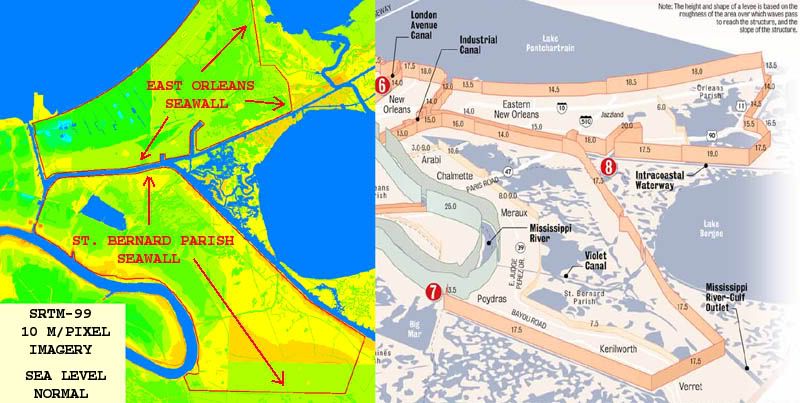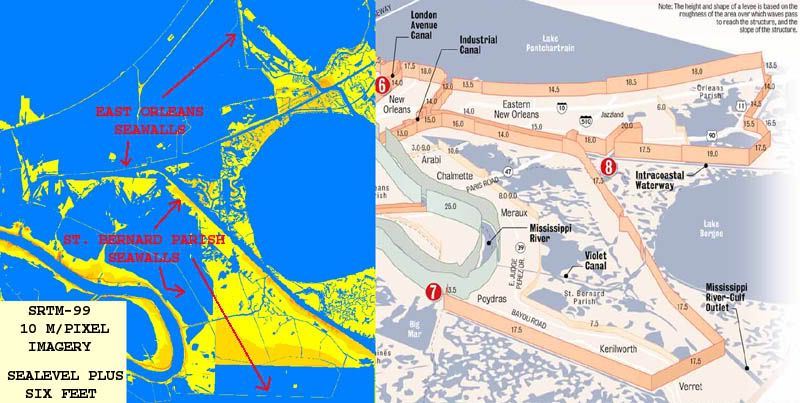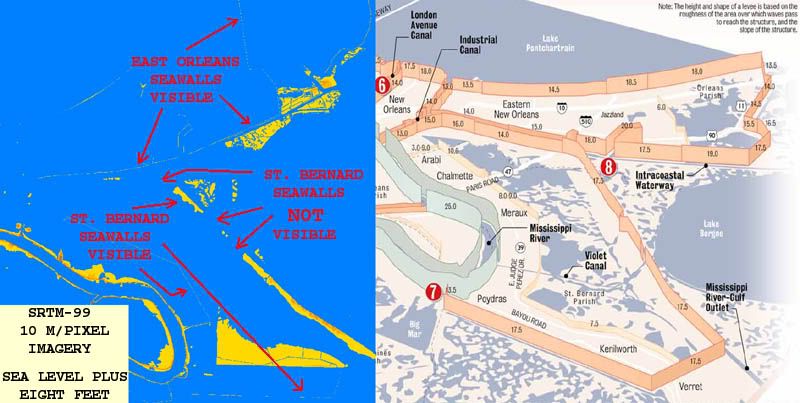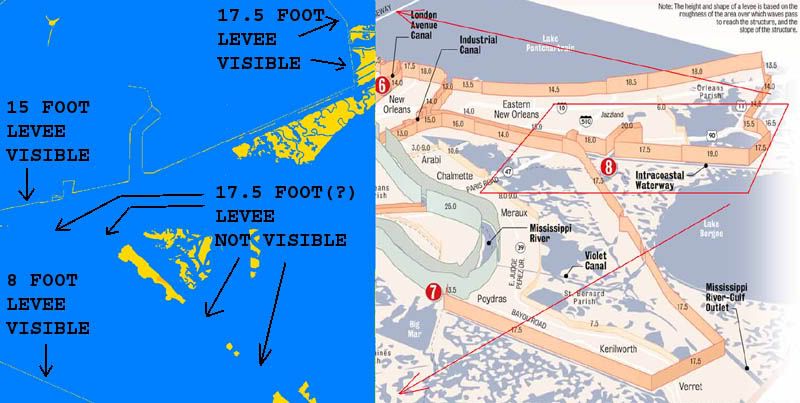Skip to comments.
Is LA Governor Blanco Hiding "Imaginary" Levees? (4 x 100 KB images)
Posted on 09/14/2005 4:39:47 PM PDT by jeffers
Several media sources have reported that LA Governor Kathleen Blanco resisted and delayed federal efforts to send aid and relief to southern Louisiana, expressing concern that if the federal government became involved, they would lay all the blame on state and local officials. This is a matter of public record. What has yet to come to light are any details which might explain Governor Blanco's apparant insecurity.
This article from The New Orleans Times-Picayune, dated June 23, 2002, notes the following significant points:
1. The New Orleans area's last line of defense against hurricane flooding is a 475-mile-long system of levees, locks, sea walls and floodgates averaging about 16 feet high. The Army Corps of Engineers says the system will protect the city and suburbs from a Category 3 hurricane that pushes in enough seawater to raise Lake Pontchartrain 11.5 feet above sea level -- high over the head of anyone standing on the other side of a levee.
That margin of error is critical because a storm that pushes the lake any higher can force water over the top of the levees and inundate the city. The water could quickly rise 20 feet or higher. People would drown, possibly in great numbers.
The corps doesn't know what that safety margin is anymore. Generally speaking, the corps says the powerful, slow-moving storms capable of overwhelming the system are rare and the levees are safe. But corps engineers say their own safety estimates are out of date, and an independent analysis done for The Times-Picayune suggests some levees may provide less protection than the corps maintains.
2. Measuring the risks of disaster is a technical feat that few understand. But such exercises are critical to the future of New Orleans. If the new corps study confirms that protection is less than previously thought, the answers could have major effects on issues such as flood insurance rates, future levee expansions, emergency planning, evacuation and long-term business decisions.
3. The landscape also is changing because of coastal erosion, sinking and even levee building.
4. Levee heights along the Mississippi River-Gulf Outlet and Intracoastal Waterway in the area range from 17.5 to 19 feet. Butler's estimates put the 100-year flood level at 16.3 feet above sea level, meaning waves on top of that would wash over the top and flood areas inside.
The historical record tends to confirm these results, Butler said. "All along the levee, there has been very high water measured there for several storms, certainly in Betsy. If you had the right kind of storm come in there, you'd really be in trouble."
http://homepages.uc.edu/~maynarjb/105/NewOrleans/NewOrleans_hurricanes.htm
In 1999, NASA launched shuttle mission STS-99, a 17 day effort which mapped over 80% of planet Earth, to a resolution of 1 meter per pixel or better, a flight more commonly referred to by computer mapping specialists as SRTM-99, short for Shuttle Radar Tomography Mission, 1999.
The 1 meter per pixel datasets are highly classified by the US military, however, the 10 meter per pixel and 30 meter per pixel datasets have been released into the public domain. These are available for download here, among other places:
http://data.geocomm.com/
Digital Elevation Models (DEMs) indicate that in 1999, levees east of St. Bernard Parish were not then at their originally specified heights above sea level. While it is possible that those sections fell victim to equipment malfunction or image resolution averaging, the following composite images demonstrate that any such failure would have had to have been highly selective.

The image above shows elevation data for St. Bernards Parish as of 1999, using mapping software calibrated to a normal sea level. Relevent levee systems are artificially highlighted in red.
In the next image below, sea level has been digitally increased to six feet above normal.

In the above image, nearly all major sections of the levee/seawalls are still visible, as they should be if they are indeed 17 feet above sea level. However, the following two images clearly show that at sea levels of eight feet above normal, large sections of the St. Bernards Parish seawall/levee system are no longer visible.

Note missing levee sections above.

A closer view of selected portions of image three.
These disturbing images leave no choice but to raise the following questions:
1. How often were these sections of the levee seawall system inspected?
2. Have they been inspected since 1999?
3. What method(s) were used during post 1999 levee inspections to determine the actual height of these structures? GPS? Laser level circuit from a known and tested benchmark? Optical transit or dumpy level circuit from a known and tested benchmark? Eyeball estimate?
4. Were these inspections carried out on the ground or by aerial survey?
5. Were any discrepancies noted during these assumed inspections?
6. What actions were taken to remedy any problems found during these inspections?
7. If it was found that subsidence had indeed lowered the seawall/levee structures, who was informed of these discrepancies, and when were they made aware of them?
8. If no discrepancies were noted, then why do high resolution shuttle radar images clearly show seawalls measured at 8, 15, and 17.5 feet, while not showing seawalls which supposedly top out at 17 feet in other nearby locations?
Given that St. Bernards Parish was the first area to flood during Hurricane Katrina, and that this area will likely yield the highest body count, these are questions that demand answers.
It is no secret that the missing levee sections noted in the above imagery include those areas most likely to fail in the event a storm surge is funneled from Lake Borgne into the Intercoastal Waterway. If these sections had already subsided and sank as far back as 1999, and local and state officials cannot document repairs since then, at the very least the public has been falsely assured, and by the reckoning of some, charges of negligence or even malicious negligence may not be out of order.
TOPICS: Crime/Corruption; Culture/Society; Government; Miscellaneous; News/Current Events; Technical; US: Louisiana; Your Opinion/Questions
KEYWORDS: failure; flood; hurricane; katrina; levee; neworleans; shuttle; space; surge
Navigation: use the links below to view more comments.
first previous 1-20, 21-40, 41-46 last
To: jeffers
Not to be overlooked is the REALLY KEY point upon which this all turns...
Your aerial shots and collating of vital levee related info demonstrates a compelling reason for Governor Babineaux-Blanco, and Mayor Nagin {assuming they were privy to this knowledge on the misuse of public monies and the dangerously deteriorated state of the levees} to have engaged in preventing independent outside organizations - governmental and private - from entering the storm zone with full access.
Once the storm and its subsequent surges, etc... have passed, it is s simple matter of explaining to the public that the levees failed, and engaging in pointing the finger of blame at the Federal government, and the Corps of engineers...
"Oh - you can't blame us - this damage was caused to the levees by a storm surge of unexpectedly immense power. the levees were in good condition before, but we were begging the Bush administration for money to improve and strengthen them - we just knew sooner or later we would have a storm like this. That we were overwhelmed is all their fault!"
With your assemblage of data - you have effectively preemptively put the lie to that entire line of reasoning, just as two other FReepers "busted" Nagin and Blanco on their lies about their response versus the Federal government's response, by creating fully functional, and easy to follow timelines chronicling the progression of events, non-events and misstatements from the very beginning - using publicly sourced media, to boot.
Once again, FReepdom outscoops the SlimeStreamMedia!
A.A.C.
41
posted on
09/15/2005 1:41:12 PM PDT
by
AmericanArchConservative
(Armour on, Lances high, Swords out, Bows drawn, Shields front ... Eagles UP!)
To: AmericanArchConservative
AmericanArchConservative wrote:
"Once the storm and its subsequent surges, etc... have passed, it is s simple matter of explaining to the
public that the levees failed, and engaging in pointing the finger of blame at the Federal government, and
the Corps of engineers..."
They're already doing this. Experts speaking to the Times Picayune have already claimed that the storm washed away whole sections of levees out east of St.Bernard. Blanco or Nagin also mentioned numerous levee failures out there during the pre Fed flap.
Your right about the implications of this too, and it can't be emphasized enough that the levee "failures", and the corruption surrounding the levee boards over decades, the whole corrupt machine down there, is the main reason for all of Blanco, Landrieu, and Nagin's seemingly inexplicable failures through the whole process.
To those of us who have been scratching our heads with every press conference in the Live Katrina threads, I assumed this would be obvious, but that was a mistake on my part. Without actual open discussion on that critical point here, will almost certainly be lost on many others.
Thanks for pointing it out.
There's still at least one major unanswered question yet to see daylight.
Why did recently refurbished levee sections, and ONLY recently refurbished levee sections in the London and 17th Street canals fail?
You can't pin this on the storm itself, not when the entire rest of the levee systems surrounding downtown stood up to the task.
You also can't hide bad construction work from the guys who actually got their hands dirty putting it up. Somewhere, somebody knows what went wrong, probably a lot of somebodies. The more attention that gets focused on this, the more likely one of them is to talk and when he does, this whole corrupt mess starts crumbling from the foundations up.
42
posted on
09/15/2005 6:44:07 PM PDT
by
jeffers
To: KevinDavis
43
posted on
09/15/2005 7:26:24 PM PDT
by
anymouse
To: jeffers; Buckhead
This might be a "Buckhead" moment.
44
posted on
09/15/2005 7:34:25 PM PDT
by
anymouse
To: jeffers
45
posted on
09/18/2005 8:00:17 AM PDT
by
bwteim
(Begin With The End In Mind)
To: ZOOKER
Given the resolution of the photos, would a much thinner concrete wall show up, or would it disappear because it's so much thinner than earthworks? First of all, they aren't photos, but rather radar images from the Shuttle Imaging Radar.
However the resolution question is still valid. It would depend on how the low resolution images were generated. If they were generated from the same radar returns, but with lower resolution processing, then the thin (<< 10 meters width) probably would not show up. However if the lower resolution images were generated from the classified higher resolution images, then it it would depend on the nature of that resolution reduction processing. If the took the highest elevation in the lower resolution (10 m) , that is larger, cell made up of 100 of the higher resolution (1 m) cells, then you would see the height of the small walls. Assuming of course that they can be seen in the 1 m resolution images. OTOH, if the averaged, or other wise smoothed, the heights from the higher resolution imagery, the effect would be similar to the lower resolution processing of the radar signals postulated above. (Similar, not the same!)
I note that in the center image, calibrated to 6 feet above sea level, the southern portion of the industrial canal levee/wall is not visible, lending some credence to the theory that the walls are not visible, since we know from ground images that it's a concrete wall at least the upper portion is.
However all those seawalls and levees that are visible in the 6 foot image, should also be visible in the last image, if they are high enough. But It's not clear without a good topo map, whether the levees/walls marked as invisible in the 8 foot image are actually visible in the 6 foot image, or are we instead seeing land or levees that are more than 6 but less than 8 feet ASL, but with concrete walls not visible by themselves.
46
posted on
09/18/2005 8:15:57 PM PDT
by
El Gato
Navigation: use the links below to view more comments.
first previous 1-20, 21-40, 41-46 last
Disclaimer:
Opinions posted on Free Republic are those of the individual
posters and do not necessarily represent the opinion of Free Republic or its
management. All materials posted herein are protected by copyright law and the
exemption for fair use of copyrighted works.
FreeRepublic.com is powered by software copyright 2000-2008 John Robinson



